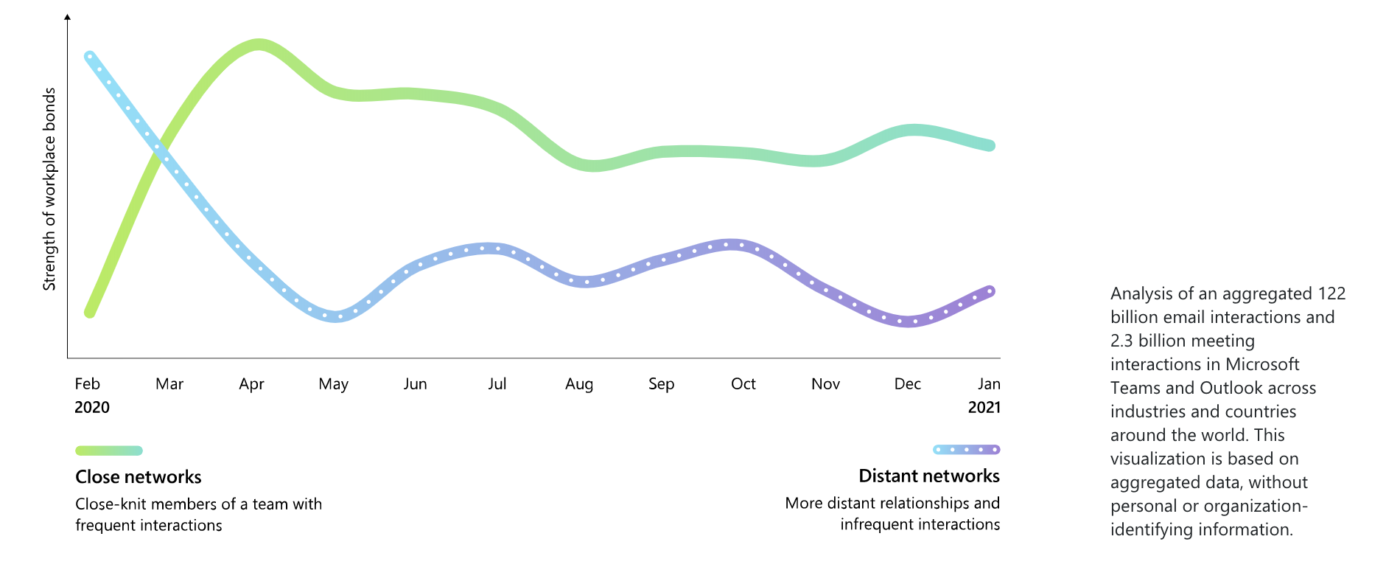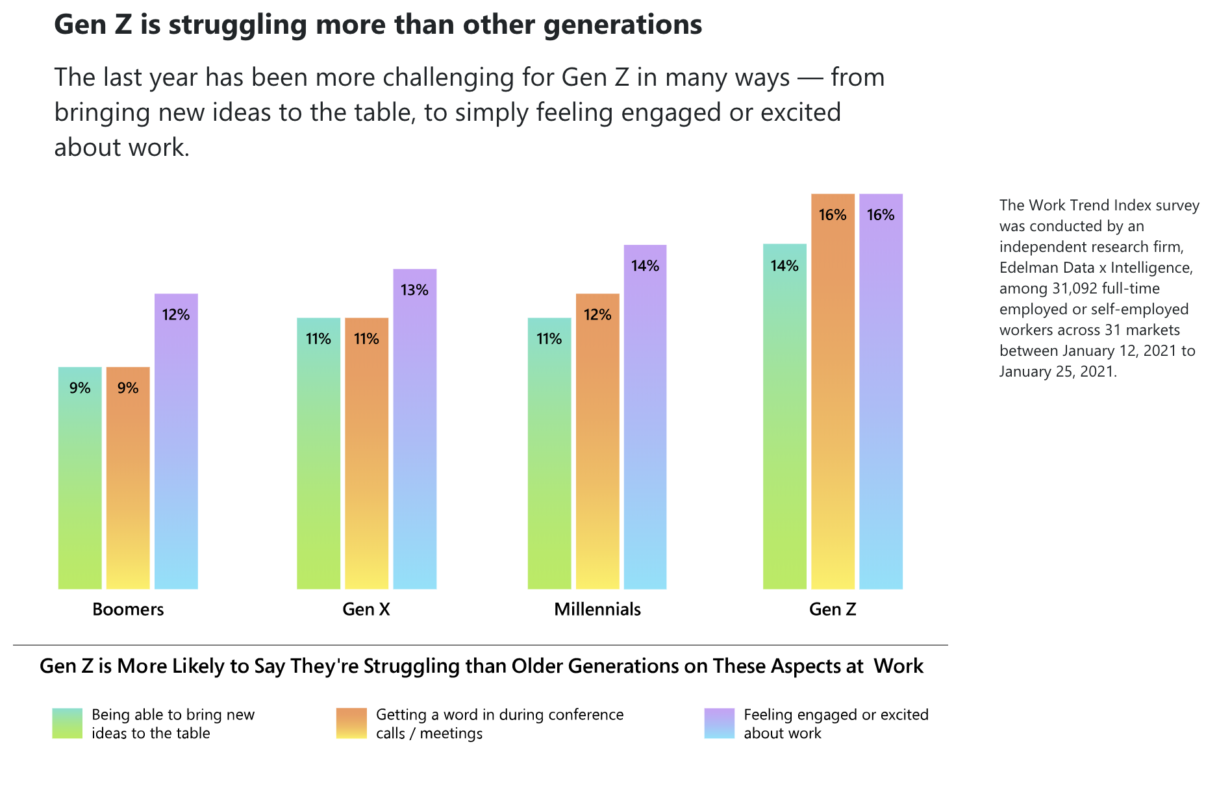In part one of HRM’s three-part series looking into the potential long-term impacts of COVID-19 on our workforce, we explore new research outlining how our connections at work might suffer.
Ever since I’ve returned to the physical workplace after months of working from home, I’ve felt slightly guilty about time spent talking to colleagues or goofing around in the office – two things I would often do pre-pandemic.
Something in my brain niggles at me when I’m not typing away at my laptop or absorbing myself in a piece of research. Keep working. Don’t stop. There’s no time for chit-chat. Stop wasting your time.
You don’t need a psychology degree to figure out what’s probably going on in my head. After a year of stress, hyper-productivity, job market uncertainty and spending a large portion of time working within the four walls of my apartment, the adrenaline that propelled me through 2020 is taking a while to wear off. I know many others feel this way too.
Nancy Baym experienced this on an even larger scale. Being based in the US meant that not only did she notice her social connections at work waning, she couldn’t go into the workplace to strengthen those bonds – she still can’t. However, instead of falling prey to the guilt monster that emerges when engaging in watercooler chat, Baym leant the other way. Every Thursday she spends the entire day jumping into video chats with various people to check in and maintain contact.
“I had the freedom to set my own priorities and goals. As soon as I made that mental switch and said, ‘Thursdays are my days to find out how everybody is doing’ it was very liberating. I didn’t feel guilty about it and no one was judging me for going around and checking in on people. This is the kind of stuff leaders and managers ought to model.”
Baym is a senior principal research manager at Microsoft US and one of the people behind Microsoft’s annual Work Trends Index, which surveyed over 31,000 employees across the globe to identify interesting trends about how a year of remote work is impacting the workforce. The Index’s findings were based on an aggregated 112 billion email interactions and 2.3 billion Microsoft Teams interactions.
One finding that was particularly interesting was COVID’s impact on our connections at work.
“Relationships take maintenance,” says Baym. “When some people are physically in the room and others aren’t, it’s a really tricky divide. It isn’t an insurmountable divide, but it requires effort. It requires intentionality, providing people with really good technology at home and setting up a lot of one-on-one time with managers.
No time to read the full article? Skip to the end for some quick, actionable tips for creating better connections at work in a hybrid environment.
Shrinking networks impact connection at work
The Index shows that our ‘distant’ networks (those outside our immediate team) shrunk as a result of COVID-19, and that 65 per cent of people are now craving more in-person contact as a means to bolster a sense of connection at work.
As demonstrated by the graph below, while distant networks got smaller, close-knit connections got stronger.
“In Australia, close to 1 in 3 workers experienced decreased interactions with co-workers compared to 40 per cent globally,” says Evan Williams, director of the Microsoft 365 Business Group at Microsoft Australia.

A benefit of stronger ties with a smaller group, according to Williams, is a greater sense of authenticity.
“[The Index] found Australian workers are more likely to be their full authentic selves at work this year compared to last, with 1 in 5 (20 per cent) having met their co-workers’ pets and families virtually this year, while a similar number (19 per cent) report having cried with a co-worker.”
He believes a shared sense of vulnerability last year had a hand in encouraging people to seek solace from their immediate colleagues and supervisors, but this also came at a cost.
“When employees lose [wider] connections, innovation comes to a halt as opportunities for new ideas shrink and groupthink becomes a serious threat,” says Williams.
Innovation often comes from unexpected places, says Baym.
“If it’s the same folks having the same conversations about the same things, it can be quite stifling. There’s empirical research looking at companies and innovation which shows that when you lose these [social] ties – the flow of communication between groups within and outside the organisation – it lessens revenue.”
Want to connect with your fellow HR peers? AHRI members can join the AHRI LinkedIn Lounge to discuss important HR topics and expand their networks.
Ephemeral communication matters
While Baym agrees that there are benefits from stronger ties with intimate groups, she warns of another potentially negative impact to shrinking distant networks: a loss of social capital.
“What those [distant network] people offer is not the daily support and being there for you, but they might know that piece of information that none of the people in your immediate world know. They might be able to introduce you to that person you really need, or they might have access to expertise and a social network of people you don’t have access to,” says Baym.
Employees miss out on the knowledge and information collected when sitting on the fringes of conversation or observing an interaction between colleagues, and while that’s not always immediately obvious, overtime it can contribute to feelings of isolation.
“Those peripheral conversations are not to be underestimated,” says Baym. “Many of the most productive parts of someone’s day aren’t when they’re sitting with their headphones on and their head down. They are the times of the day when they have an unexpected conversation that’s super energising and unlocks something in their brain.”
A lack of spontaneous contact is difficult to emulate in a virtual environment, but not impossible (see tips at the end of this article).
“It’s hard to exert the same kind of energy when the spontaneity of being in the same place is taken away.”
Younger workers less connected
Microsoft’s Index notes that younger workers (18-25 years old) are most likely to be struggling with a lack of connection and will potentially feel the impacts of a lack of social capital/distant networks the most.
“This generation is more likely to be single and early in their careers, making them more likely to feel the impacts of isolation, struggle with motivation at work, or lack the financial means to create productive workplaces at home,” says Williams. “They also reported difficulties feeling engaged or excited about work… and bringing new ideas to the table.”
“It’s hard to exert the same kind of energy when the spontaneity of being in the same place is taken away.” – Nancy Baym, senior principal research manager at Microsoft US.
“One reason I’ve heard [for this] is that young people are more likely to be living alone and therefore to be more isolated in general,” says Baym. “Or they rely on work as a source of social engagement with the world more than older people who may have families that they’re going home to.”
Networking – an already daunting prospect for many people – is much harder virtually, Williams adds. Those who are entirely new to the workforce might not have had the opportunity to meet their colleagues face-to-face yet.
“Without meaningful conversations and strengthened relationships, their engagement and overall career satisfaction will suffer,” says Williams.

Rebuilding connections at work
Williams warns employers and employees not to become blindsided by the benefits of remote and hybrid workforces.
“In the years to come, managers will need to evolve their ability to model, coach and care for their employees and incorporate virtual techniques to ensure no one is left behind. In turn, employees will need to develop the skills to connect both face-to-face and virtually to keep their work relationships warm no matter where they are.”
Williams offers the following tips to introduce more connections at work in a hybrid environment:
- Set up a structure that encourages cross team collaboration: Appoint a team leader to set up a recurring time, whether weekly or fortnightly, for employees across teams to connect.
- Ensure structured time is also fun: Leaders should ensure connection time is balanced with informal interactions, such as team trivia or contests.
- Do the small things well: Encourage managers to structure consistent employee recognition, celebrate birthdays and acknowledge successes (and learn from mistakes) where a team has taken risks.
Some of Baym’s tips, which are expanded upon in this Harvard Business Review article, include:
- Dedicate time to building social capital: Simply telling employees to expand their networks won’t work, says Baym. You have to give them opportunities to do this and that might mean lessening their workload and balancing resources to ensure they have emotional energy left to network.
- Rethink what you reward: If employees are feeling guilty about dedicating time to developing social capital, Baym says it can help to publicly reward people for supporting their employees and taking the time to connect. So rather than focusing bonuses, promotions and rewards on an individual’s accomplishments, open this up to include people’s efforts to connect with their colleagues.
- Look out for those staying quiet: It’s important to have someone advocate for those less likely to speak up to ensure meetings are inclusive (especially considering the Index’s finding that 18-25 year olds are struggling to get a word in during meetings).
- Facilitate connections for employees: We’re going to have to be more intentional with introductions and inviting people to networking opportunities in the coming years.
Expanding on this final point, Baym says it’s important to remember that relationships matter.
“They take time and are inextricable from the work we do. People who are really good at [building relationships], who foster sociality, collegiality and connection in their workplaces, don’t necessarily get credit for it. They’re just seen as really nice and friendly. But this is a skill you should value and nurture in your team,” says Baym.
“I’m generally quite optimistic about relationships. I think they’ll heal, but I think it may take more active work on the part of managers.”
Keep an eye out for the second and third instalments of this series over the coming weeks.
(Interested in HRM doing a deep dive into a specific topic on the long-term impacts of COVID-19? Let us know in the comment section. Or tell us how your connections at work have shifted this year).


Being intentional about fostering social interactions, building cross functional and external relationships is so critical . Agree that this isn’t a skill that is valued and recognised